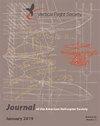Leading-Edge Suction Behavior of Unsteady Airfoils in Forward and Reverse Flows
IF 1.4
4区 工程技术
Q2 ENGINEERING, AEROSPACE
引用次数: 0
Abstract
To model unsteady airfoil aerodynamics in forward and reverse flows in a simple and robust manner requires a strong understanding of the complex flow dynamics and their relation to first-order concepts. The current work explores the relation between the leading-edge suction force, represented nondimensionally by the leading-edge suction parameter (LESP), and the flow physics of forward and reverse dynamic stall as a function of freestream Reynolds number, airfoil thickness, and motion kinematics for the NACA 0012, 0015, and 0018 airfoils using computational tools. The relation between the LESP and critical events associated with leading-edge vortex (LEV) shedding was found to be independent of flow direction barring the signature to identify LEV initiation. Leading-edge suction was observed to continue to increase after LEV initiation in reverse flow and could be attributed to the combined effect of a weak LEV and strong trailing-edge vortice. While LESP, forces, and moments were found to be moderately dependent on airfoil thickness and strongly dependent on the Reynolds number in forward flow conditions and the critical LESP, in addition, was weakly dependent on motion kinematics, the aerodynamics were observed to be largely independent of said parameters in reverse flow. This allows for a single critical LESP value to be used for symmetric airfoils to indicate LEV initiation when the blunt edge is experiencing reversed flow, a finding which serves to largely reduce the empirical dependencies while modeling unsteady reverse dynamic stall in low-order methods.非定常翼型在正反流中的前缘吸力特性
以一种简单而稳健的方式模拟非定常翼型的正向和反向流动需要对复杂的流动动力学及其与一阶概念的关系有深刻的理解。目前的工作是利用计算工具探索前缘吸力(由前缘吸力参数(LESP)表示)与NACA 0012、0015和0018翼型的自由流雷诺数、翼型厚度和运动运动学的函数之间的关系。研究发现,前缘涡与前缘涡脱落相关的临界事件之间的关系不受流动方向的影响,限制了识别前缘涡起始的特征。在逆向流动中,前缘吸力在LEV启动后继续增加,这可能是弱LEV和强尾缘涡的共同作用。而LESP,力,和时刻被发现是适度依赖于翼型厚度和强烈依赖于雷诺数在向前流动条件和临界LESP,此外,是弱依赖于运动运动学,空气动力学被观察到很大程度上独立于上述参数在逆向流动。这允许在对称翼型中使用单个临界LESP值来指示当钝边经历反向流动时的LEV启动,这一发现有助于在低阶方法中模拟非定常反向动态失速时大大减少经验依赖性。
本文章由计算机程序翻译,如有差异,请以英文原文为准。
求助全文
约1分钟内获得全文
求助全文
来源期刊

Journal of the American Helicopter Society
工程技术-工程:宇航
CiteScore
4.10
自引率
33.30%
发文量
36
审稿时长
>12 weeks
期刊介绍:
The Journal of the American Helicopter Society is a peer-reviewed technical journal published quarterly (January, April, July and October) by AHS — The Vertical Flight Society. It is the world''s only scientific journal dedicated to vertical flight technology and is available in print and online.
The Journal publishes original technical papers dealing with theory and practice of vertical flight. The Journal seeks to foster the exchange of significant new ideas and information about helicopters and V/STOL aircraft. The scope of the Journal covers the full range of research, analysis, design, manufacturing, test, operations, and support. A constantly growing list of specialty areas is included within that scope. These range from the classical specialties like aerodynamic, dynamics and structures to more recent priorities such as acoustics, materials and signature reduction and to operational issues such as design criteria, safety and reliability. (Note: semi- and nontechnical articles of more general interest reporting current events or experiences should be sent to the VFS magazine
 求助内容:
求助内容: 应助结果提醒方式:
应助结果提醒方式:


